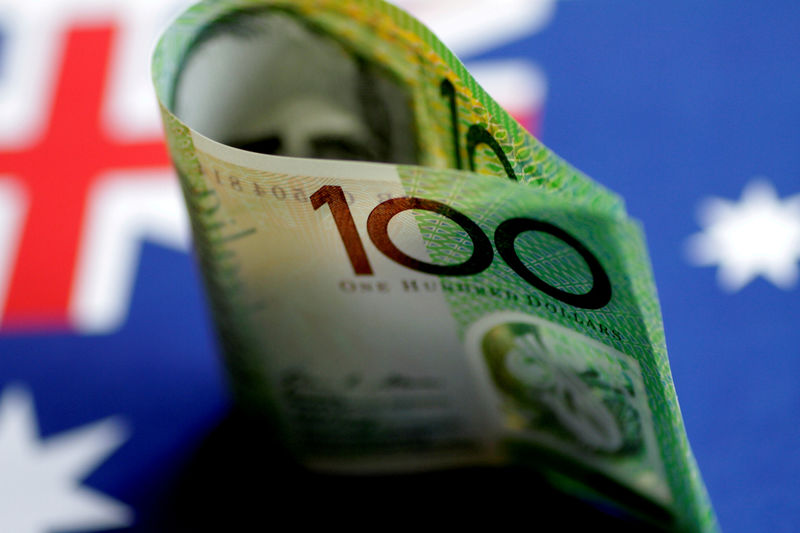 © Reuters. FILE PHOTO: Illustration photo of an Australia Dollar note
© Reuters. FILE PHOTO: Illustration photo of an Australia Dollar noteBy Swati Pandey and Wayne Cole
SYDNEY (Reuters) – The Australian dollar is paying for the sins of others as investors short the commodity-exposed currency to 2-1/2-year low as a hedge against risks to global trade, China and emerging markets.
Yet having the world’s whipping boy currency is ironically just what Australia needs right now as it faces falling home prices, moribund wages and stubbornly low inflation.
The , widely used as a liquid proxy for global growth, lost more than 8 percent of its value so far in 2018 as currency crises in Turkey and Argentina cascaded to other emerging markets.
It plumbed to $0.7085 on Tuesday, the weakest since February 2016, and some traders see further losses with speculative short positions in the currency near three-year highs.
But the very success of the bears in weakening the Aussie is making Australian assets from bonds to real estate to infrastructure more attractive to foreign funds.
Foreign direct investment into Australia accelerated to an annualized A$84 billion ($60 billion) last quarter, the strongest six-month pace since early 2012.
“With the Aussie falling, our investors who’ve had exposure in the U.S. market are getting comfort in switching their holdings back into Australian dollars. So we are seeing that trend,” said Stephen Mackie, Brisbane-based director of fixed income at FIIG Securities.
Australia has seen its government debt grow rapidly in the past decade to A$534 billion and around 60 percent of that is held offshore, mostly by central banks.
Despite that debt binge, Australia can still borrow money at a lower cost than the United States. Just last week, yields on Australian 30-year government paper () dropped below those on Treasuries for the first time ever.
Australia’s coveted AAA-rated status, prudent fiscal spending and strong economic growth over the past 27 years make it an attractive investment destination.
Offshore purchases of Australian government bonds last quarter was the largest since late 2015, although analysts are puzzled as to where the extra buying has come from.
Robert Thompson, Sydney-based macro rates strategist at RBC, cited two syndicated issuances this year for which geographical breakdown showed strong interest from Asia ex-Japan followed by North America, the United Kingdom and then Europe.
“Perhaps higher yields led by the United States, a lower Australian dollar and firmly on-hold RBA encouraged a rotation into Australian debt as a relatively high-yielding safe haven”, Thompson said.
The Reserve Bank of Australia (RBA) has kept its official cash rate at an all-time low of 1.50 percent for more than two years now and has given a clear signal that policy will remain accommodative for some while yet.
PROFIT BOOST
A lower Aussie is benefiting other parts of the economy too, although the point is lost on the local media which treats the currency’s steep decline this year as a badge of shame and an omen of doom.
A depreciating currency has a huge force multiplier in Australia because the majority of its A$400 billion ($284.64 billion) in annual exports are resources priced in U.S. dollars.
So when the Aussie falls it automatically boosts the bottomline for exporters, delivering a huge windfall to profits and national income.
Operating profits at miners in the June quarter jumped 22 percent on a year earlier, and that was before the latest slide in the Aussie to a two-year trough.
The boost from profits was a major reason growth in the overall economy sped to 3.4 percent in the year to June, the fastest in six years and ahead of even the United States.
The profit bonanza has helped the country’s benchmark equity index (), dominated by miners and banks, climb to a decade high recently although the index has since eased amid a global sell-off.
The index is still on track for its third straight annual gain.
For sure, a lower Aussie will also lift the cost of imports but that is far from unwelcome when inflation has been stuck below the RBA’s target band for 2-1/2 years running.
Indeed, the country’s central bank is thrilled by the fall, having spent the last couple of years trying to talk it down to little effect.
That feel-good sentiment was evident in comments made by RBA Governor Philip Lowe in a speech last week.
“The Australian dollar has depreciated. If sustained, this could be expected to improve the outlook for both inflation and growth.”
Source: Investing.com



























